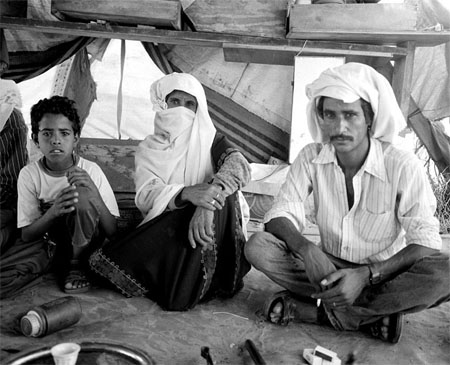
Fadhiya Abu Ghurood. Photo: Peter Fryer
|
|
 Fadhiya Abu Ghurood. Photo: Peter Fryer |
|
Fadhiyya Abu-Ghurood, Bir Hadaj (Naqab), April 6:
|
|
The journey south is long. The terrain begins to change a few miles out, more arid than around Lakiya, more desert-like. Most of the land on the right is a military zone, fenced off with barbed wire which goes on for mile after mile. On the left we pass several electricity installations with Azazmeh 'tents' (black plastic) lying under them in clefts of sandy hills - a fine illustration of the submission of the 'primitive' to the 'modern'.
After a while we give a lift to a young bedouin man with a woman and a baby, who directs us which turning to take off the main road. None of the road signs have Arabic place names on them. Soon after we turn off we come to a large herd of camels near a wooded enclosure, with a tourist bus parked nearby. Yusif, the driver, searches for someone to ask the way. It's then I realize that he knows no more than I do how to reach Bir Hadaj. A stern young man who I assume to be Israeli but who speaks Arabic asks us who we are and why we want to go to Bir Hadaj. The name 'Dakhilallah' (the local sheikh) reassures him. He draws us a map. We have to go over a bridge, pass the turning to Revavim and go on until the turning to Rehamit. This we take, but must leave the tarmac road and go through bedouin settlements until we reach a mosque. There we should ask anyone we see for Fadhiya. We reach the turning for Rehamit, and start to drive over stony dirt soil spotted with widely spaced black plastic 'tents' - all the while without seeing a single living figure, neither adult, child or animal. After a while we do indeed see a mosque, recognizable only because of the double megaphone jutting from its roof. But both the mosque and the nearby 'shigg' are deserted. Eventually we spot a man with a child in the fenced off garden of a shack. We ask him if he knows where Fadhiya's house is. He has a car and offers to lead us there. There follows a long, winding journey through scrub, for around five more kilometers. It's now that Yusif shows the first signs of impatience, muttering ironically "Fadhiyya, ya Fadhiyya!" Finally the car in front stops. We see a fenced-off shack-tent like the others. A youngish man comes out to greet us, and then Fadhiyya herself. We embrace. She's a tiny skin-and-bone figure wrapped in a black, barely embroidered dress and white 'mandil'. Not much of her is visible except her eyes. She keeps her 'mandil' across her mouth as she speaks, but when it drops for a second I see that her left nostril is cut to carry a |
nose ring which is no longer there. This old wound mesmerizes me, and I fail to notice her hands and feet. But I think she was barefooted.
There is a level of poverty here that I haven't seen before. The tent is empty. No hens are scratching in the dirt 'garden' outside, nothing is growing there, or anywhere in sight. There's no TV. No water. Yusif the driver enters the 'tent' with me, and sits and asks Fadhiyya many questions, so I have his voice on tape too. After such a long drive I feel he has a right to join in. Perhaps it's a sign of Fadhiyya's public fame that he feels free to do this. Perhaps Fadhiyya invited him in. But I am surprised, since normally a man would never enter domestic space where he has no relative by blood or marriage. The young man who first welcomed us has disappeared. There's only an orphaned grand daughter.
Fadhiyya Abu
Ghurood begins speaking: The drive back to Bir Sab'a is simple. We reach the bus station by early afternoon. I pay off Yusif and queue up for a bus to Tel Aviv among a crush of soldiers beginning weekend leave. By early evening I'm in Jaffa. The luck of having found Fadhiyya, the contrast between her impoverished environment and her fiery spirit, give me a sense of elation that lasts for the rest of the day. |
|
[Umm Taleb and Umm Hatem] [April 6-9, Jaffa] Copyright©2005 |
|
|